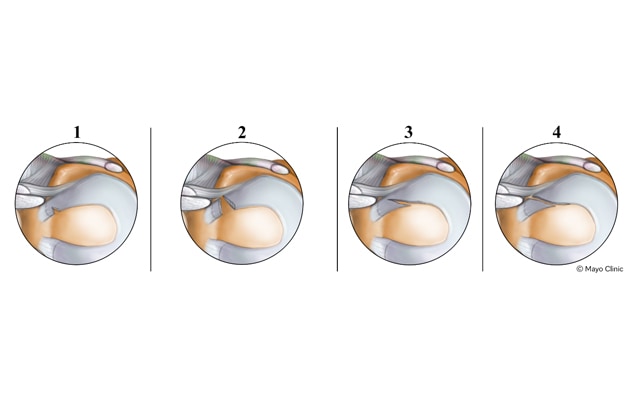Dec. 20, 2022
Michael J. Stuart, M.D., an orthopedic surgeon and sports medicine specialist at Mayo Clinic's campus in Minnesota, says that in his more than 30 years of practicing sports medicine, he has observed lateral meniscus oblique radial tear (LMORT) lesions — a tear of the lateral meniscus posterior horn and a separate issue from a meniscal root tear — as the most common tear in an acute ACL injury. LMORTs differ from other meniscal tears in factors such as location, oblique configuration and association with acute ACL injury.
LMORT levels

LMORT levels
Images depict LMORT levels 1 to 4.
Dr. Stuart, Aaron J. Krych, M.D., an orthopedic surgeon and sports medicine specialist from Mayo Clinic's campus in Minnesota, and colleagues from the University of Missouri continue to research LMORTs, as described in the following summary. The bottom line: LMORTs, especially types 3 and 4, are distinct meniscus tears that need to be recognized and repaired.
2020 published findings: LMORT lesion description, classification system
In a first-of-its-kind publication in a 2020 issue of Orthopaedic Journal of Sports Medicine, Dr. Stuart and collaborators described the LMORT lesion, providing a four-level classification system for tear severity and distance from the root attachment to the bone.
"The LMORT lesion has been observed by many surgeons, but they likely believed that a meniscus tear in the avascular region had poor healing potential, so they typically resected the unstable portion," says Dr. Stuart.
The multicenter study utilized a retrospective cohort design to analyze 200 consecutive acute ACL reconstruction cases from three surgeons, totaling 600 patients. Of these ACL injury cases, 66% exhibited concomitant meniscal injury, of which 12% — what he calls a high incidence — exhibited LMORT lesions. This led to the development of a cadaveric model to study the effects of LMORT3 and LMORT4 lesions on knee stability.
2021 published findings: LMORTs lead to biomechanical consequences
Orthopedics researchers at the University of Missouri optimized the testing sequence with matched cadaveric knees to first create ACL injuries, then both LMORT3 and LMORT4 lesions. They used robotic technology to perform pivot shift and anterior drawer simulations and ultrasound to measure meniscus extrusion at varying knee flexion angles. In cadaveric knees with ACL tears plus an LMORT3 or LMORT4 lesion, anterior drawer and pivot shift increased, and lateral meniscal extrusion worsened compared with ACL injury alone.
"This study demonstrated the LMORT3 and LMORT4 biomechanical effects were significant, with meniscus function and joint stability negatively impacted," says Dr. Stuart. "It clearly indicated the importance of recognizing and treating this specific meniscus tear for the success of ACL reconstruction surgery and for long-term knee health."
Mayo Clinic and University of Missouri colleagues published these findings in the American Journal of Sports Medicine.
2022 published findings: Untreated LMORTs compared with partial meniscectomy or arthroscopic side-to-side repair
These investigators then demonstrated that the two most severe types of LMORT should be repaired at the time of an ACL reconstruction.
A 2022 American Journal of Sports Medicine article showed that failure to treat an LMORT3 or LMORT4 leads to meniscus extrusion as well as joint instability, especially pivot shift and anterior translation.
"The untreated or resected LMORT compromises lateral meniscus function," says Dr. Stuart. "Meniscus extrusion results in higher ACL graft forces, which may result in a greater risk of surgical failure."
Lateral meniscus deficiency, especially for a young person, is problematic, says Dr. Stuart, as the meniscus contributes to joint stability, shock absorption, nutrition and lubrication. The absence of meniscus function also can translate into more pain.
Additional insights on LMORTs
Dr. Stuart also says that the surgical approach for ACL tears with LMORT3 or LMORT4 lesions is critical.
"Our research to date supports meniscus repair with sutures, rather than meniscectomy," says Dr. Stuart. "Meniscus preservation can restore kinematics and decrease the risk of articular cartilage deterioration and subsequent arthritis.
"Orthopedic surgeons now have a higher degree of appreciation for the different types of meniscus tears, improved repair techniques and biologic enhancement. We're more aggressive now with meniscus tears," he says. "Before, we did not think we had an alternative to resection. We now believe that LMORT tears can heal after suture repair."
The next step in the research process for Dr. Stuart and colleagues is conducting a study of LMORT tears in the clinical setting, including a case-control series of LMORT repairs versus partial meniscectomies.
For more information
Krych AJ, et al. Lateral meniscal oblique radial tears are common with ACL injury: A classification system based on arthroscopic tear patterns in 600 consecutive patients. Orthopaedic Journal of Sports Medicine. 2020;8:2325967120921737.
Smith PA, et al. Kinematic analysis of lateral meniscal oblique radial tears in the anterior cruciate ligament-deficient knee. American Journal of Sports Medicine. 2021;49:3898.
Smith PA, et al. Kinematic analysis of lateral meniscal oblique radial tears in anterior cruciate ligament-reconstructed knees: Untreated versus repair versus partial meniscectomy. American Journal of Sports Medicine. 2022;50:2381.
Refer a patient to Mayo Clinic.